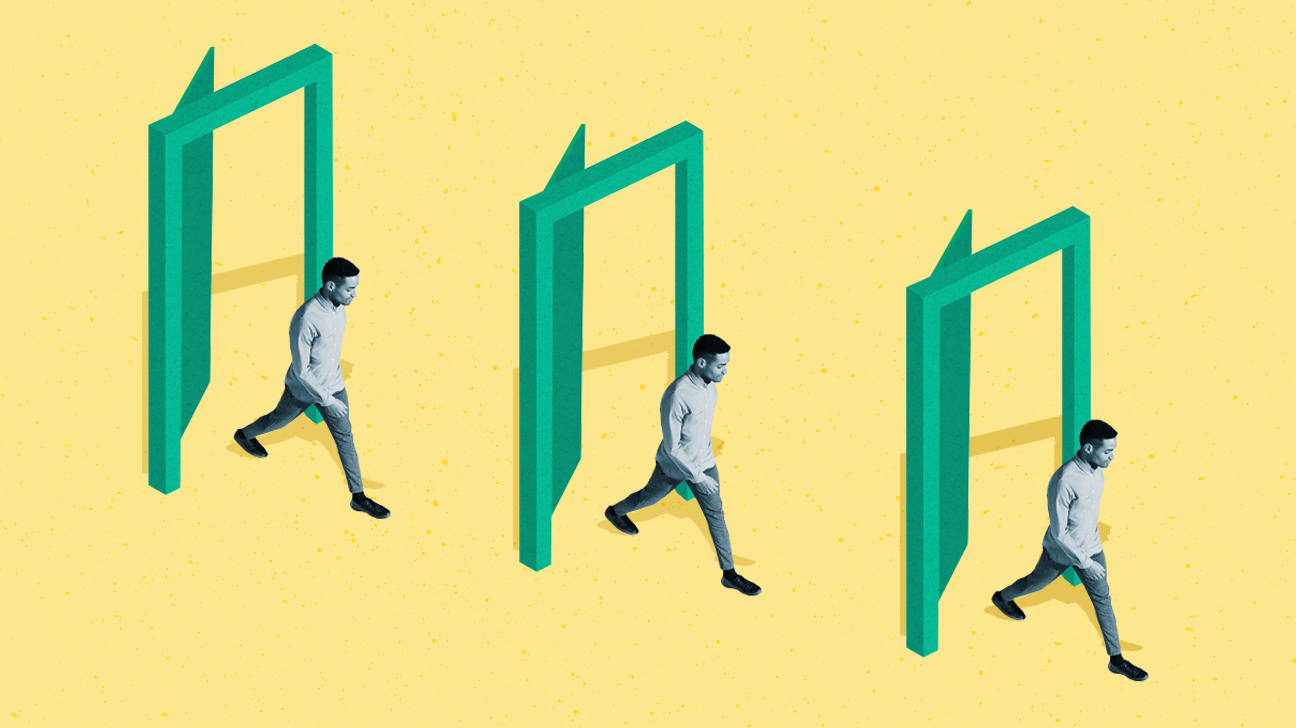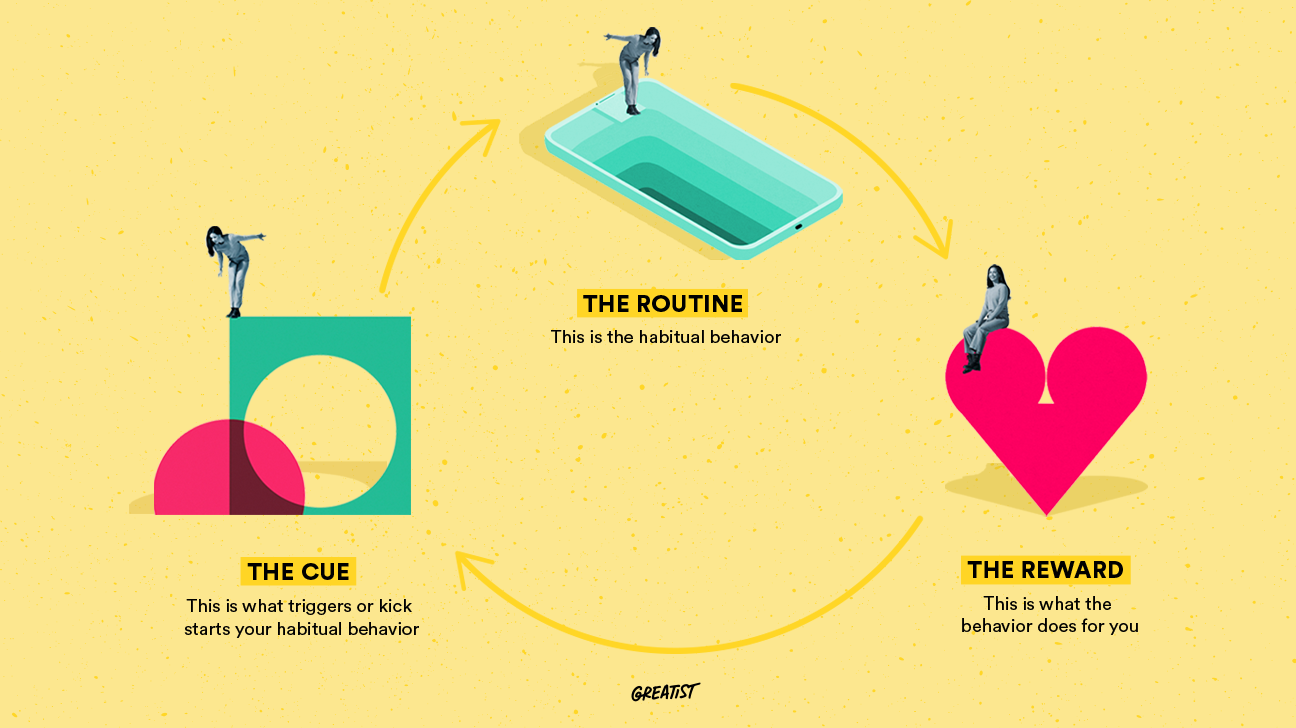Breaking unwanted habits is hard. So hard that “Linkin Park,” “Destiny’s Child,” and “The Offspring” all made megabucks from songs about it. But their admittedly catchy tunes don’t actually help you kick habits. That’s what Charles Duhigg’s theory about habit loops is for.
Habit loops 101
Habits are routine behaviors that we carry out almost subconsciously and struggle to stop doing even if we want to. We might not want to — good habits exist, too.
Being snagged in a habit loop isn’t the same as a diagnosable addiction. But some (pretty weak) studies have suggested that habitual behaviors can be precursors to, or part of, addictive use or behavior disorders.
Habit loop mapping is increasingly incorporated into CBT treatments for conditions that have habitual elements, like disordered eating.
Despite its super helpful brain science and therapy implications, the habit loop idea was cooked up by a journalist (Charles Duhigg). He wrote a book called The Power of Habit: Why We Do What We Do in Life and Business.
Habit loops are his helpful framework for explaining, well, habits.
If you’re trapped in a habit loop and want out, here’s the 411!

What is a habit loop?
The journalist Charles Duhigg introduced habit loops to the world in his book The Power of Habit.
His goal was to create a framework for understanding how/why habits develop (so we could break them). He also kinda knocked it out of the park. Habit loops are an accessible, tried-and-tested way for us to understand our habitual behaviors and kick them in the pants. Go you, Duhigginator! Big up yourself.
The super simple version of Duhiggie Smalls’ habit loop framework is:
- The Cue: This is what triggers or kick-starts your habitual behavior.
- The Routine: This is the habitual behavior.
- The Reward: This is what the behavior does for you, like making dopamine or unmaking stress.
See? Super simple to understand. Now let’s elaborate the sh*t out of it.
How does knowing about habit loops help break unwanted habits?
Good question. Kicking a habit isn’t as simple as declaring, “OK, I’m going to stop doing this now.” If it was, nobody would have heard of our boy Charles Duhigg.
Habit loops help by providing a framework for understanding your habits as patterns of behavior. It’s hard to break a habit if your understanding of it is, “this is just something I do, leave me alone.” Viewing your habit loops as cause-and-effect behavior patterns makes the road to habit-free living way easier to navigate.
Cue, routine, reward: Habit loops explained

Now it’s time to dive deep into the brain mechanics behind Chaz H’s habit science.
Cue (or reminder, or trigger)
This is what kicks off your habit behavior.
A cue can be anything.
- It could be a time of day, like your morning alarm acting as a cue for teeth-brushing.
- It could be a song, like Shakira’s 2005 smash “Hips Don’t Lie” triggering compulsive salsa dancing. Or any song by Snoop Dogg giving you the urge to spark up a joint.
- It could be a physical/emotional sensation, like mild arousal prompting habitual masturbation prior to 45 minutes of crying in the shower.
There’s no rules about what can and can’t be a cue. Cues for your habit are unique to you, your habit, and your daily life.
Routine
This is the “habit” part of the habit loop. It’s the thing that you do that you can’t stop doing.
Routines aren’t necessarily bad. Teeth cleaning is a habit that’s irrefutably good for you and your gnashers. That’s not the kind of habit Charlie-boy was interested in stopping, though.
Routines in an unwanted habit loop could involve stuff like eating junk food or humming “Baby Shark.” It’s anything you do that you don’t want to do but can’t help but do if given the cue. (Dr. Seuss, is that you?)
Reward
The reward is the bit that makes your brain go, “this is great, I’m going to do this as much as I possibly can.”
With good habits, the reward could be clean teeth. For bad habits, the reward could be the decadent taste of cinnamon rolls.
It’s the reward that reinforces the habit routine. Obviously, the nature of the reward depends on the habit. That’s why we dive into some specific examples below.
Examples of habit loops you might be stuck in
Wondering how the habit loop framework can be applied to some real-life unwanted habits you may be dealing with? Sit yourself down and turn on your learning glands, because we’re about to drop some applied knowledge all up in this.
Weed smoking habit loop
Latin name: Habitus Fourtwentycus
An estimated 4 million people in the USA meet the diagnostic criteria for marijuana use disorder. Even if you’re not one of them, it can still be hard to put down the blunt for those who live that blazed life.
Many people habitually smoke cannabis for its stress-relieving qualities. Despite what your friend Stoner Dave tells you, cannabis is addictive. In a lot of marijuana use disorder cases, habitual smoking was the first step toward a more serious problem.
The cannabis/stress relief loop entraps a lot of people due to weed’s documented habit-forming properties. Once you’re in the loop it’s difficult to de-stress without Seth Rogen’s favorite plant, which makes turning down Mary Jane a pain for the brain. (Seriously, Dr. Seuss, if that’s you, knock it off.)
If you feel personally attacked by that paragraph, here’s how your love of the high-grade works as a habit loop:
- Cue: Life throws some Grade-A bullsh*t your way and stress happens.
- Routine: 🎼 Hey hey hey… smoke weeeed every day… 🎤
- Reward: You feel less stressed. Also, you now understand the plot of most “Adult Swim” shows.
*That was a quote from a song, not an instruction. Daily cannabis use isn’t good for you. Take a break from the wake and bake. (This is your last warning, Dr. Seuss. Cut it out or we’re getting HR involved.)
Doomscrolling habit loop
Latin name: Habitus Zuckerbergus
Social media‘s great, isn’t it?
False, social media’s not great. It’s well-documented that social media is linked to a buttload of mental health concerns. So think twice about posting that selfie.
Mental health bad times from social media aren’t just found in the self-esteem damage that chasing likes and followers can cause. Compulsive social media use (or passive social media use) is what concerned psychologists are calling that nasty doomscrolling habit you can’t seem to kick.
We’re only just beginning to understand social media addiction (also, full disclosure, it’s not currently recognized in the DSM-5). Habitual social media use isn’t full-blown addiction, but a lot of folks still struggle to keep it in check. We could all do with cutting down on newsfeed time, but habitual doomscrolling is a loop many want rid of.
Want to understand the lost minutes you spend dissociated in the void? Here’s doomscrolling as an easy-to-understand habit loop:
- Cue: You’re on social media.
- Routine: Your brain switches off and you scroll through your feed (sometimes for hours) bombarding your senses with information.
- Reward: Your brain releases a fat wad of dopamine.
Online shopping habit loop
Latin name: Habitus Paypaloopsica
Compulsive online shopping doesn’t seem like a big deal until you remember it can leave people in thousands of dollars in debt.
We’re all guilty of making the occasional cheeky impulse buy. However, many people experience online shopping as a damaging habit. Online shopping addiction isn’t yet a medically recognized condition, but making online purchases as a habitual behavior is well-documented.
So yeah, your doc may not be able to prescribe treatment for your Amazon splurges, but at least the science nerds back your corner when you protest that you say controlling yourself is hard.
Here’s what the online shopping habit loop you’re stuck in looks like to Charles “heck your medical science, I’m a gosh-dang journalist” Duhigg:
- Cue: You’re bored and see something nice online.
- Routine: You buy it in just a few clicks/finger swipes.
- Reward: The anticipation/excitement of knowing a shiny new thing is coming in the post. Plus, you know, whatever the new thing is when it arrives.
Breaking out of habit loops
We wouldn’t be talking about Charles Duhigg if habits weren’t tough to break. Part of the reason his book is so darn helpful is that it gives us a working framework to kick them (as opposed to “just stop doing it, lol.”)
Step 1: Identify routine
This is the easy bit. You have to figure out what your habit routine is. Let’s use the weed stress relief habit as an example. The routine would be “When I’m stressed I roll and smoke a blunt until I’m not stressed.”
Step 2: Create new rewards
Habits develop because our routines bring rewards. Continuing with the 420-themed habit loop, the reward is the stress-busting power of being high.
To break the habit loop you’ll have to find new rewards that scratch that same/similar itch. So if you want to kick the pot habit you’ll need a different way to de-stress, which might be meditation or masturbation (it’s best to avoid getting caught in that habit loop, too, but it’s cheaper for sure).
Step 3: Map your cues
For step 3, you’ll identify the cues and triggers which trigger your reward-giving habit routine.
When you find yourself caught up in the routine make a note of:
- location (e.g. your house)
- time (e.g. straight after work)
- emotional state (e.g. stressed)
- people around you (e.g. your housemate, Stoner Dave)
- your last action (e.g. sitting down in front of “Aqua Teen Hunger Force” and taking the blunt Stoner Dave passed you)
Before long, you’ll start to identify patterns.
Step 4: Avoid your cues
Now you know your cues, you can take steps to avoid them. These could be little changes, like doing some exercise between getting home and sitting down. They could also be drastic ones, like locking Stoner Dave in a closet (we jest).
Combine these cue-avoiding behaviors with your new reward structure for habit-smashing success.
Everyone works differently
As useful as the habit loops model is, it’s not going to work for every person or kick every habit.
Habitual behaviors might have links to some addictions and mental health conditions, for example. And they’ll only fade if the underlying cause is treated. There are also other options for habit-kicking, like hypnotherapy.
Don’t get stressed if your habit loop-breaking plan doesn’t help you stop doing what you don’t want to do anymore. If stress is one of your cues, that’s only going to make you lean more into your habit.
It could be that the habit is deeply ingrained and will take longer to crack. If you’re concerned it may be symptomatic of a more serious condition, speak with your doctor.
Takeaway
Habit loops are a nifty tool for understanding habits made up by Charles Duhigg. They come in three parts: cue, routine, and reward.
Understanding your habits as routine behaviors that happen when a cue triggers the reward-response in your brain is mad helpful for helping to counter them.
Charles “Getting Duhiggy with it” Duhigg recommended mapping your cues and setting up alternative reward activities as the way to beat your habit routines.
Everybody is different though, and his neat little habit loops theory is far from the be-all and end-all of habit-kicking.

0 Commentaires